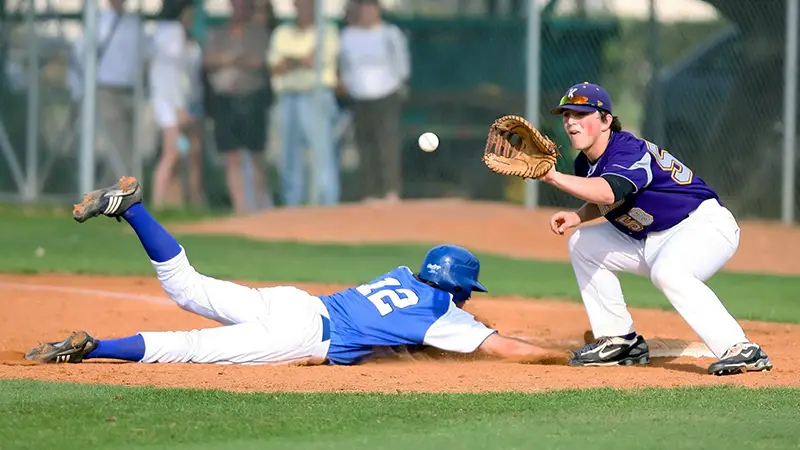In the world of baseball, few things frustrate a hitter more than popping out. Coaches, players, and parents often believe that a pop-up results from swinging up too much.
However, this common misconception overlooks the real mechanics of a successful swing. Surprisingly, pop-ups often occur because the bat doesn’t move up enough, not the other way around.
Successful hitters typically employ a slight uppercut to make solid contact with the ball, creating line drives and driven flyballs.
This approach contrasts sharply with the traditional advice of maintaining a level swing or staying on top of the ball.
In fact, taking a downward or level path to the ball reduces the time the bat and ball are on the same plane, increasing the likelihood of grounders or weak pop-ups.
Understanding the true cause of pop-ups can revolutionize a hitter’s approach at the plate, leading to more consistent and powerful hits. By embracing the slight uppercut, hitters can significantly improve their chances of success.
Understanding “Popped Out Baseball”
The term “Popped Out Baseball” doesn’t seem to have a widely recognized specific meaning in baseball terminology or slang.
However, based on context, it could potentially refer to a situation where a baseball pops out of a glove or a specific type of hit or play involving a pop-up.
Here are a few interpretations that could make sense:
Difference Between a Pop-Up and a Fly Ball
Pop-ups and fly balls both involve the ball being hit into the air, but they differ in height and trajectory. A pop-up has a steep, high arc, often staying within the infield or just beyond it.
An example would be a ball hit that peaks quickly and comes down near the pitcher or shortstop. Fly balls, on the other hand, have a more gradual ascent and longer distance, typically reaching the outfield.
Outfielders deal with fly balls often, as they travel higher but also cover more ground. Understanding this distinction helps players and coaches develop better strategies for positioning and catching.
Common Causes of Popping Out
In the context of baseball, “popping out” typically refers to a specific type of batted ball or a fielding error.
Here are some common causes or scenarios where “popping out” might occur:
Pop-Up Fly
This is a common occurrence where a batter hits a ball high into the air with relatively little distance. It’s often an easy play for a fielder to catch if they can get underneath it in time.
However, if the fielder misjudges the ball or takes a bad angle, they might “pop out” of position, potentially missing the catch.
Fielding Errors
Sometimes, when a fielder attempts to catch a pop-up or a high fly ball, they may momentarily secure the ball in their glove but then “pop out” due to the impact of landing or collision with another player.
This can lead to the ball popping out of their glove and potentially allowing the batter to reach base or advance.
Glove Issues
Occasionally, a fielder’s glove might not securely hold onto the ball due to the ball’s trajectory or the glove’s positioning. This can result in the ball popping out even after what initially appears to be a successful catch.
Wind or Sun
Environmental factors such as wind or sun can also contribute to a fielder “popping out” of position. Wind can affect the trajectory of the ball, making it harder to catch cleanly. Sun glare can also impair visibility, leading to misjudgments or errors.
Infield Fly Rule
In specific situations (usually with runners on base), an infield fly rule may be called by the umpire. This rule is designed to prevent fielders from intentionally dropping a pop-up to create a double play opportunity. If a fielder misjudges or mishandles a pop-up in these situations, it can lead to confusion or an error.
Why Hitters Frequently Pop Out
Hitters frequently “pop out” in baseball for several reasons, each stemming from aspects of their swing mechanics, pitch characteristics, or situational factors.
Here are some key reasons why hitters might pop out:
Mechanics of a Swing Leading to Pop-Ups
Swing mechanics significantly influence whether a hitter pops out. When the swing path is too flat or downward, the bat often contacts the lower part of the baseball.
This results in a high, weak fly ball, known as a pop-up. Incorrect hand positioning during the swing can exacerbate this issue.
If the hands drop too much or lead too early, the bat angle tends to shift downward, leading to weak contact and higher chances of popping out.
Adjusting the swing path to ensure a slight upward trajectory can mitigate this problem, producing more solid contact and fewer pop-ups.
Impact of Bat Angle and Swing Timing
Bat angle and swing timing are critical in determining the outcome of a hit. An improper bat angle, particularly one that is too steep, causes the ball to be hit with a trajectory that goes upward rather than outward.
This usually results in pop-ups. Timing also plays a crucial role; if the hitter swings too early or too late, the ball is not struck at the optimal point for driving it forward.
By refining timing and adjusting the bat angle to meet the ball at a better point in the swing arc, hitters can reduce the incidence of pop-ups and increase the chances of driving the ball into the field.
Techniques to Minimize Popping Out
To minimize popping out in baseball, hitters can focus on improving their swing mechanics, pitch recognition, and situational awareness.
Here are several techniques and strategies that can help reduce the frequency of pop-outs:
Adjusting the Batting Stance
Fine-tuning a batter’s stance can significantly impact the likelihood of popping out. A proper stance involves aligning the feet shoulder-width apart, bending the knees slightly, and positioning the head steady. This promotes better balance and helps maintain control over the swing.
Hand positioning also plays a crucial role. Keeping the hands relaxed and close to the body ensures a smoother swing path.
By gripping the bat lightly, hitters can achieve more flexibility and precision in their swings, reducing the chances of hitting weak pop-ups.
Swing Modification Drills
Incorporating specific drills into practice routines can help hitters minimize pop-outs. One effective drill involves the use of a batting tee.
By setting the ball at different heights, batters can practice maintaining a slight upward swing path. This helps in developing muscle memory and improving contact consistency.
Another valuable drill is front toss drills. Coaches or partners softly toss the ball in front of the batter, allowing them to focus on their swing mechanics.
Emphasis should be on maintaining the bat’s angle slightly upward while making solid contact with the ball.
Lastly, video analysis can be extremely beneficial. By reviewing footage of their swings, players can identify flaws in their form and adjust accordingly.
Slow-motion playback helps in pinpointing issues like improper bat angle or poor timing, enabling precise corrections and improvements.
Transforming Your Swing Mechanics
Transforming your swing mechanics in baseball requires deliberate practice and a focus on fundamental adjustments.
Here are key approaches to effectively modify and improve your swing mechanics:
Implementation of a Slight Uppercut
Adopting a slight uppercut in the swing can significantly reduce pop-ups and improve hitting power. High-level hitters often use a modest uppercut to square the ball effectively and produce more line drives.
The angle at which the bat contacts the ball is crucial. If the bat meets the ball too flat, weak pop-ups are likely.
By adjusting the swing to achieve a slight upward path, the likelihood of making solid contact increases. Therefore, hitters should focus on this adjustment in their swings.
Key Drills to Enhance Swing Plane
Several drills can help enhance the swing plane, making it easier to achieve a slight uppercut.
Batting Tee Drills
Position the tee at various heights to practice hitting the ball with a slight upward swing. Adjust the tee to simulate different pitches, making sure the hitter focuses on maintaining an upward trajectory.
Front Toss Drills
Have a coach or partner toss balls from a short distance in front of the batter. The hitter should focus on driving the ball upwards, ensuring their swing path is not too level.
Video Analysis
Recording the swing and reviewing the footage can help identify and correct flaws. Pay particular attention to the swing plane to ensure it aligns with the desired slight uppercut.
Frequently Asked Questions
What causes a pop out in baseball?
Pop outs in baseball often occur when the batter swings with a downward or level path, causing weakly hit fly balls. Adjusting to a slight uppercut can help improve hitting success.
What adjustments can be made to minimize pop outs?
To minimize pop outs, batters should adjust their batting stance, hand positioning, and practice swing modification drills.
Which drills are recommended for improving swing mechanics?
Drills like batting tee drills, front toss drills, and using video analysis are excellent for enhancing swing plane and ensuring a slight uppercut.
Can video analysis help improve a batter’s swing?
Yes, video analysis allows batters to closely examine their swing mechanics and identify areas for improvement.
Conclusion
Embracing a slight uppercut in the swing can significantly reduce pop-outs and enhance overall hitting performance.
Adjustments in batting stance and hand positioning, coupled with targeted drills like batting tee and front toss, are essential for refining swing mechanics.
By incorporating these techniques, players can achieve a more effective swing plane, leading to more line drives and better offensive outcomes.
High-level hitters consistently use these methods to square the ball efficiently, demonstrating the value of a slight uppercut in modern baseball.
Furthermore, understanding the importance of launch angle and exit velocity can also contribute to minimizing pop-outs.
Coaches and players should utilize technology such as swing analyzers and video review to fine-tune mechanics and make data-driven improvements.
Consistent application of these strategies not only boosts individual performance but also enhances overall team success.








Pat Bloom